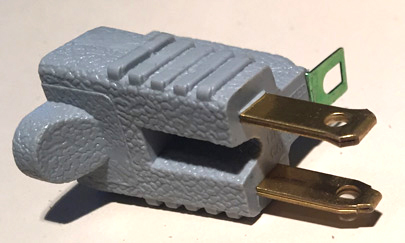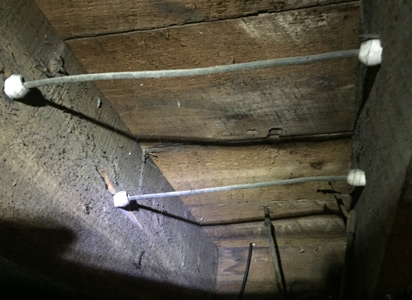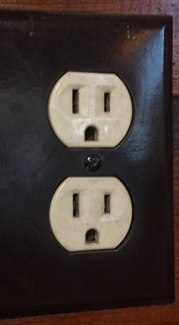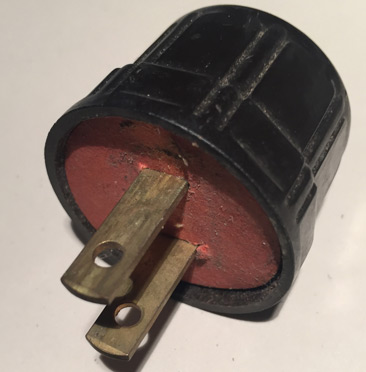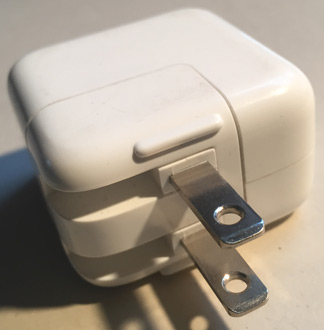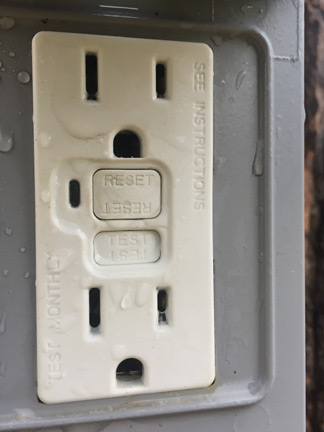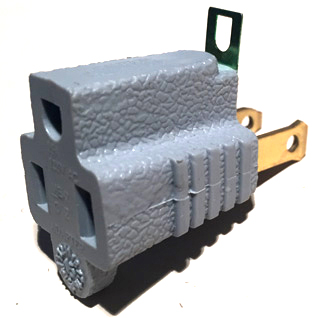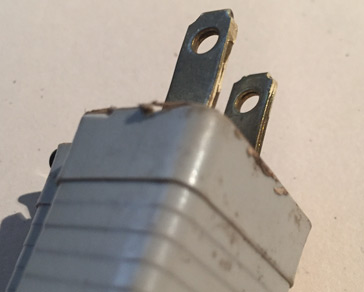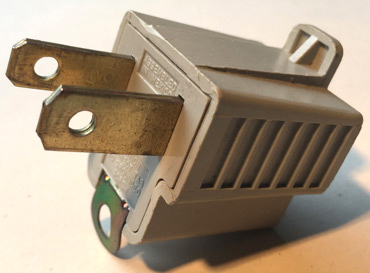 H
H 
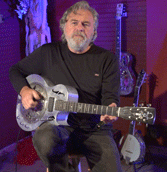

|
|
The Indispensible and Controversial 3-Prong Adapter
This is the story of a simple and inexpensive device that you will likely need to learn to use if you are a performing troubadour. "Experts" and the government publicly tell you never to use them, yet millions of people do. If you don't, you may have unsolvable problems when you perform. Sound like a familiar story? You can probably think of analogous situations in other fields of endeavor, where familiar household products or common pastimes have been outlawed or viified– like raw milk, home births, diving boards, genuine Italian prosciutto, playground equipment, 55 mph speed limits and oil-based paint. Nonetheless, large numbers of people cheerfully ignore the warnings and continue the controversial activity because it works for them, they like it, or they have always done it. Welcome to another chapter in the confusing search for truth. I can't find an article in a magazine or any "voice of authority" telling you what I am going to share with you here, though this is pretty common "street knowledge" and it's a little much to call this "subversive," "outlaw" or "renegade." (This is the kind of thing they now call a "Life Hack" on YouTube videos.) I have been a performing musician since 1974, and I have carried a sound system to thousands of gigs in thousands of different venues, ranging across almost the entire spectrum of small to mid-sized performance gigs (50 to 400 people) in private and public places. The tips and perspectives I include here come from long experience, which I am sharing in hopes of helping others solve a nasty and frequent problem in amplified music. I find myself wondering if some place like the Berklee College of Music is graduating musicians without ever dealing with this subject, which I feel is of vital importance to any performing musician who uses amplification. If I ran a troubadour school I would devote at least part of a class to this subject. There is problem-solving, though you don't need to study electrical engineering or understand Ohm's Law to get involved here. Along with "science," there is also some genuine mystery involved, since things do not always make total sense out there in the world of playing gigs with amplifiers and speaker in random buildings. You can easily come to feel like you are chasing evil spirits out of your musical gear as much as scientifically addressing issues. NOTE: Any of you who are reading this in countries other than the U.S. might not get much from it, since I am not familiar enough with the electrical systems overseas to know what applies and what doesn't. THE PROBLEM Sometimes when you plug in an amplifier or PA system, a very noticeable hum or "buzz" may sound in the speaker, and it can be enough to distract your audience and ruin your performance if you can't get rid of it. The true cause of it can be impossible to determine during the time period you have to deal with it when you have a gig, but it generally means that the wiring in the venue is interacting with your gear in a detrimental way. You may have to make a "Hobson's Choice" of either having annoying noise in your speakers, or perhaps taking what some people say is a risk. The root of this problem is that the electrical safety code, in trying to help keep us from getting electric shocks, has helped to create a situation that sometimes makes our sound systems hum loudly. Before I get into the hum-fighting stuff, I want to take you through a quick tour of wires and electricity, mostly so I can use some terminology to talk about things... HISTORY OF THE PROBLEM WIRES & POLARITY I live in a house built in the 1880s, and it still has some leftover old "knob & tube" wiring in the basement that has likey been there over 100 years. This clearly illustrates that two wires make up a circuit, and that the 2 wires used to be installed as separate wires. These were strung across ceramic posts about 6-8 inches apart as they were threaded through the walls to do their job. Some people call them a major fire hazard, while others have told me that the system is actually safer than modern wiring because the 2 wires are physically so far apart that short circuits are difficult. The chipmunk would have to have his feet on one wire while biting the other to fry anything. Each wire is coated in some kind of early plastic or asphalt sheathing. (When my wires were installed, it's likely that all circuits in the house shared a "common ground" wire, which was then an accepted practice they called "haywiring." This is considered a serious "no-no" nowadays, which you might guess from the name. But I digress...
For about the last 50 years, electricity in the U.S. has traveled mostly through "non-metallic" or "NM" wires, (commonly called "Romex") where the black and white wires are each insulated with a coating of thick plastic, and then another layer of plastic sheathing goes around them both. When those wires get attached to a plug, they go into an outlet to allow electricity to happily flow through the circuit and safely deliver power to things. The Romex wire is often encased in metal conduit pipe or "armored cable" for added protection. The "problem" we are addressing here stems from the fact that electrical outlets in the U.S. generally have 3-prong receptacles like this, where the 2 flat holes also are different sizes:
You've probably wondered all your life why some devices have 3-prong cords and some just 2, and also why some but not all of the 2-prong plugs have one blade wider than the other. We have all been constantly annoyed by plugs with larger blades on one side. They are trying to make sure we put the two parts of the circuit where they belong. The word "polarity" refers to keeping track of which of the two wires goes where, and which hole each of the 2 wires that make up the circuit goes into in the outlet. There is sometimes but not always a difference in what happens if you reverse the 2 wires, even though the A/C current is switching direction 60 times a second in every circuit. Supposedly the manufacturers of each device work out the permissions with the government reguators who oversee electrical consumer products, so that they have proper polarized or un-polarized plugs as needed. You'll find that a light bulb will make light just fine and an old radio will still play if you reverse the positions of the two blades of the plug. This was the first big government regulation to try to address electrical safety as more and more homes were connected to the power grid. Only quite old outlets have equal-sized receptacles that you could plug into either way. The smaller blade of the plug is reserved for the hot (black) wire and the larger blade for the white or neutral. Here is a very old light bulb plug from my collection that has equal-sized blades that can go into a socket either way. It is probably 50 years older then this recent iPhone charger that also has equal-size blades:
Nowadays many products have electronics and computer chips in them that are more finicky than early devices like electric motors and lights. Switches are always wired into the black (hot) wire so that it gets interrupted when the switch is flipped, so lamps and appliances with switches typically have a wide and a narrow blade in their polarized plugs. The chargers for my iPhone and laptops all have equal-size blades, and can be plugged in either way, as can my 50-year old vacuum cleaner. This is because so-called double-insulated products do not require 3-prong (grounded) cords. You may have some power tools or even pretty high-wattage electrical devices without a 3-prong plug. There are meetings and agreements reached between manufacturers and regulators for each product that hits the market, and unless you are using an electrical device that is more than 50 years old, you needn't worry that it has an incorrect plug. (There are enthusiasts who try to upgrade old electric guitar amps from the 1950s to address these electrical safety issues without compromising the legendary sound or value of the vintage equipment. If this interests you, go find some online discussions.) GROUNDING The second and probably the largest government intervention into electrical building codes was to insist that all outlets and many devices have a 3rd connector, the so-called ground. This began in 1971 when 2-prong outlets were outlawed in the U.S., and is what has led to the hum problem we are addressing here. I played my first gig in 1974, so I have been dealing with this problem for my entire career. The purpose of the 3rd “prong” in electrical devices is not that it does anything or makes anything work better. It is a redundant ground wire, so if by chance something went wrong with the wire and the “neutral” (white) wire broke or became disconnected while the “hot” (black) wire still worked, or if the outlet were wired backwards, then the electricity would have a nice copper wire path to the earth and would not need to go through you. That’s basically all the 3rd wire is for, though it also prevents us from reversing the polarity since it plugs in only one way. The extra grounding wire is also what causes the humming in our speakers, by connecting things that we are not trying to connect. Some people think the ground wires are a government gift to the copper industry, since it adds close to 50% to the cost of all wiring and only very rarely carries any electricity. Both the neutral wire and and the extra “ground” wire connect to the same grounding bar in the breaker (fuse) box. The need for the 3rd wire most often happens when a “hot” wire inside an electrical device with a metal casing slips free or the insulation is damaged, and the hot wire touches something it shouldn't, like the metal case. If the housing of an electrical device gets juiced and there is not a 3rd wire or the system is not grounded, then you can get a shock if you touch it, since your body will complete the circuit. Like water finding the shortest path down a hill, electricity takes the easiest path. It would much rather travel through a copper wire than your body, luckily. NOTE: The third big government intervention into our electrical wiring is the GFI or GFCI "ground-fault" outlet that are now required for outdoor wiring as well as wet places like kitchens and bathrooms. These have a different shape than "regular" grounded outlets, plus a reset button for the built-in circuit breaker.
These outlets contain smart but finicky electronics that try to keep us from getting electrocuted by essentially having a circuit breaker in the outlet itself. It quickly shuts off power inside the outlet itself if it detects problems. I won't go into detail here, since whatever problems they cause (yes, they can solve one problem while causing others) are not really DIY solvable on the job. You can't realistically ask to have them removed or rewire the venue yourself with a non-GFCI outlet so you can do your gig. If your gear is tripping a GFCI outlet you might want to play unplugged, find a long extension cord and try to plug in somewhere else, or tune to the annoying hum in your speakers. They frequently trip when there is not a real danger, and you often need to replace them with a newer GFCI outlet that is less fussy. Corrosion of components of electronic devies can do unpredictable things. Weird little spiders and ants are often attracted to electricity, and sometimes crawl up inside outdoor electrical things like these and compromise the electronics. Back to music and those annoying humming sounds... There are two basic situations you face as a troubadour performer: 1) You bring a sound system and operate it yourself. 2) You perform and someone else provides the sound system. Luckily, the hum issue is usually a binary situation: either there is a hum or there isn't. If you get rid of it you can move on and do your gig, though if you can't, you look like an amateur. There are fewer problems and less risk if you are operating your own sound system, since a big cause of the hum is that you the performer are sometimes plugging into AC power in a different part of a room from where the PA system itself is plugged in to the power. If you bring your own gear, you have an idea if it is damaged or might be likely to leak electricity, and you can't make those assumptions if you are using a PA that has been in a bar or coffee shop for a few years. If you only sing into a mike, there are usually no problems. It's when you connect some of your gear to AC power that is also connecting via a microphone cable to the PA system that you may get the 60 cycle hum because your gear may be bridging two systems that are connected to wall current in different places. You can often isolate the problem by observing that the sound system has no hum until you connect to it. If you unplug from AC power on stage the hum may vanish. That's a scientific first step to take to identify the source of the problem. It often occurs that the soundman will have the PA set up and running, with no hum, and then at sound check a hum appears, caused by something you introduced into the situation. Your gear may not always have this problem, and the same can be true of the soundman at the gig; it's the interaction of the two systems that may cause the problem, usually triggered by you plugging into AC power. (You usually won't have this problem if all your stage deviced are battery-powered. You also avoid a lot of electrical dangers if you use wireless mikes and instruments, though they are prone to other kinds of annoying but not dangerous problems.) More specifically, the hum in your speakers is caused by the connection of the systems to the wiring in the building, which creates a larger system that contains the hum. There are a number of other kinds of electrical hums and buzzes that amplified musician gear can face, and this particular type of hum, often called a "60-cycle" hum, because that is the frequency of the alternating current that has been used in American electricity since the days when George Westinghouse began implementing Nikola Tesla's wonderful but slightly mystical invention of AC current around 1900. (It's quite maddening that 60 cycles is not a musical note, and it can be hard to tune and perform with it going on.) It is a hum that musicians learn to recognize, and it's part of troubadour field training to learn to deal with it. If you were to ask an electrical engineer, they would assume that this was due to an old building with faulty or antiquated wiring, though I swear on a stack of Bibles that I have had this problem a few times in new buildings and renovated buildings with new wiring done supposedly to electrical code, as well as in older buildings. We aging musicians often perform and live in older buildings, and have dealt this these issues for decades. It's usually called a problem with "grounding" and the most common cause of this is a “redundant ground,” most often referred to as a “ground loop.” It is commonly caused when a musician on stage plugs their equipment into a wall outlet on stage, and connects via a microphone cable or multi-channel snake to a mixing board or amp that is plugged into a different circuit in the building. For this reason, sound companies and musicians usually try if possible to plug everything in the sound system into the same outlet or circuit if possible. (Plugging lights into those same circuits, especially those with dimmer switches, can be problematic in other ways that we won't go into here.) If you are doing a small gig somewhere, and you encounter this problem, running an extension cord from the stage or from the soundboard so that all the gear on and off stage is plugged into the same power strip will solve the problem in a high percentage of the situations. When you use a small sound system that does not pull too many watts, this usually does not overload a circuit. Most circuits wired into a wall outlet are 15 or 20 amps, and as long as you don't draw more current than this, you are fine with this technique. The average troubadour basic sound system pulls much less current than a toaster. The gear I bring to a concert pulls less than 160 watts, which is 1/10 of a typical hairdryer, and is about 7% of what a 20-amp circuit can handle. You have the option of accepting the advice of the electrical code enforcers, and thus you must also accept the hum in your speakers or try to deal with solutions like those offered by Ebtech, Audioholics or Techhive. These all involve convoluted explanations, and expensive gear that no one I ever met owns or uses. A web search for "ground loops" yields a lot of confusing and irrelevant results, and often involves the word "dangerous" which I question. The easy solution that we troubadours often resort to, is to use one of these, which Audioholics make a point of saying you should never use:
This device changes the way your devices plug into the wall by ignoring the 3rd connector (the ground) of a 3-prong plug, and essentially pretending it is 1970. It's your choice whether or not to disgregard the advice of the supposedly knowledgeable electrical people in order to remove the grounding hum. If you are wiring your home studio, or doing a permanent installation, then of course you should not rely on defeating the ground wire. This is a "quick & dirty" thing we sometimes do when we go play a gig for a few hours. If you web search for "musicians electrocuted" you'll find most of the search results come from Europe where they have 220 volt power. I will tell you, and I would tell a congressional invesigation that I and many of my musician colleagues have "hacked" this system with ground lifting adapters thousands of times without injury to people or damage to equipment, and would not hesitate to do it any time it was warranted. I hope some readers will send me links to news stories of musicians who were injured or killed by using ground lifters, and prove me wrong. I can't find any, and am suspicious that it's another of those fictional demons we are told to fear. Marijuana is also labeled as a Schedule 1 dangerous drug, and in its 6000 year history I don't think it has ever seriously hurt anyone. Driving 10 miles over the speed limit or talking on a cell phone while driving are really dangerous, and kill people all the time, but we all do those activities, and some people leave loaded guns around the house. TO LIFT OR NOT TO LIFT Musicians and sound men usually call them ground lifters, or just lifters, though they are also called "cheater plugs," "3-prong adapters" or "polarized grounding adapter" or something similar. They are among the least expensive and most common electrical products, and they are sold everywhere for about a dollar. If they were really that dangerous or illegal, why would they sell them at every grocery store? Is this an example of us having too many laws and regulations? Here is a page by a DJ who admits to using them. Here is a forum of people talking about grounding and amp safety as it relates to 2 vs. 3-prong cords. It's kind of amazing how everyone sounds right, yet the "truth" does not really emerge as you compare the stories and advice of more and more people. This is typical of many "Googling for truth" missions I undertake, so I will tell my story and share what I know and do, and encourage you to make your own decisions. Ground lifters allow you to plug a grounded, 3-prong plug into an outlet that only has an older, ungrounded 2-prong receptacle. You are supposed to attach the little metal clip to a ground or a screw in the outlet, but few people bother. If you live or work in an old building, or if you are over 40 years old you are probably used to them. I am suggesting here that you should bring one to every gig, and I am surprised how often I have faced a situation where the soundman did not have their own. It's almost funny how controversial these things are, and I am often tempted to make a T shirt with a huge picture of one on the front. Many people who are "trained" in electronics are leery of them or otherwise unwilling to use or own them, presumably because admitting that lifters are useful calls into question the validity of the soundman's knowledge base and education. The fact that lifters can be valuable and have worked safely for millions of people should carry more weight, and you would think that any soundman would always have a couple of them, but don't count on it. If you don't bring one yourself, leave yourself time to make a quick trip to the store before the gig starts. If you are self-taught and have some gig experience, you'll probably already own several. If you hear a hum when you are setting up your sound sytem, you invest 15 seconds, put a lifter where your power connects to the wall, and it stops the hum. A simple, clean, fast and inexpensive solution, but not without some fine print. Apparently one thing you lose when you use a "cheater plug" is the benefit of whatever electrical surge protection you might be using with your gear. Surge protectors use the ground wire to get rid of extra or unwanted current when there is a spike in the line. It is illegal to even suggest in the manual for an amplifier or piece of electrical equipment that someone use a lifter, and I may even come under fire here for recommending that you use one. The mysterious and all-powerful Underwriters Laboratories that reviews and approves any consumer device that plugs into a wall outlet, does not allow the instructions to any piece of gear to even float the possibility that the user might try one of these adapters when plugging in an electrical device. It is also illegal to squeeze milk out of a cow's udder and sell it to someone without pasteurizing it in many states, and in some places in America it is illegal to deliver a baby with a midwife. Yet huge numbers of people do these things, and we musicians use ground lifters at many of our gigs, trading the certainty of better sound for the uncertainty of possible risk. Jimmy Carter was the first U.S. president to be born in a hospital. Were all those other families reckless? All kinds of people, educated and uneducated, have used these adapters for decades all over their living spaces without giving it a thought, and there are probably tens or hundreds of millions of them in use every day all over the country. There are so many warnings on electrical gear we use now that it can be hard to even find the real instructions, and we get used to ignoring product warnings on lamps and toasters, which is of course not always good, especially when electricity is involved. It's a much more serious problem in countries that use 220 volt current, since the electrical shocks are more severe than with 110 volt. Some musical gear, such as electric guitar amps, is manufactured with a "ground" or "polarity" switch, that reverses the polarity of the electrical signal for you or might even lift the ground. This may have the same effect as if you reversed the plug or removed the 3rd pin of the plug where it plugged into the outlet. If you have a hum in your speaker, first look carefully for tiny ground switches on the back of your gear and try flipping or reversing them. That's what they are for, and you can stay on the good side of the Underwriters Laboratory. I have owned and operated dozens of sound systems for over 40 years, and have never had problems or heard of any damage to any equipment or electrical shocks to any other musicians as a result of using ground lifters. The classic "musician gets an electric shock on stage" situation usually happens when the musician is 1) touching the strings of an electric guitar that is 2) plugged into an amp that is plugged into a wall socket and then touches their lips to a microphone that is connected to the mixer and power amp. You get a jolt of electricity in your lips, which can be quite painful, which means that something wasn't grounded or was wired wrong somewhere. Electric current is leaking into the shield of the microphone, and the musician's body completes the circuit. Search for "musician shock lips microphone" and you'll find lot of stories and advice, that varyingly say to 1) test outlets at your gig before you set up your gear to make sure they are wired correctly 2) put a foam windscreen on the microphone or wear rubber-soled shoes 3) plug the stage gear and the house PA system into the same circuit 4) use wireless mikes and guitars or 5) modify your electric guitar to add a resistor to block current flow. In my troubadour world where I play acoustic instruments, the strings don't carry current, though I have been shocked many times by vocal mikes, which is part of the reason I always bring my own vocal mike with a foam windscreen. Bill Whitlock, an audio engineer who has written on the subject, says “the cheater plug has been identified as a serious safety problem. Its casual use as a method for avoiding ground loops in analog audio and video signals (to eliminate hums and buzzes) is dangerous,” and claims that in 1997 nine people were electrocuted using consumer audio and video devices. Considering that over 300 million people used audio and video devices every day of that year puts the percent of deaths from consumer A/V equipment at a staggeringly small number of deaths per million. The government-published 20-year average rate of 50 deaths per year from lightning strikes seems to indicate that vastly fewer people died using sound gear improperly than from lightning. Further considering that people use audio and video gear all day long and do not spend every day of the year in lightning storms might make one wonder why using a lifter is called “dangerous.” As you doubtless already suspect, you can get informed, confused and/or alarmed if you consult online forums and discussions of the pros and cons of using ground lifters. Be aware that it's your decision whether to use a lifter at your gig. When you use a lifter, you trade an unknown but likely small amount of safety for the immediate reward of better sound. If you are about to use a lifter and the gig is outdoors in a wet or potentially wet situation, on a boat, or in a swamp, or if a lightning storm is in the forecast, you might want to re-think your plan or your personal risk-acceptance limits. If your amp works and does not shock you or trip the breaker when you plug it into a 3-prong outlet, then that is an indication that it is working properly and that there are no loose wires flopping around inside. If you wiggle and shake all your gear and the power cords, while it is making the hum, and no fuses blow, you can can consider making the calculated risk to use a ground lifter to remove the hum so you can do your gig. If it does not remove the hum, then by all means remove the lifter. Though I will confess that for a long time I toured and performed without injury where I plugged my on-stage gear into a 6-foot, 3-outlet extension cord where the 3rd prong was accidentally broken off. (This is another solution to the problem if you have a hum in your PA and have no lifter, you can be a law-breaking renegade and saw or break off the 3rd prong on a power strip or extension cord. Another more drastic Life Hack, with the same effect as using a lifter, but chances are the soundman won't even notice and can't scold you or roll his or her eyes.) Most of the gear I use on stage is pedals that will run on battery or AC power, and reversing polarity or lifting grounds does not seem to affect them at all. I asked my banjo-playing-Nobel-Prize-winning-physicist-Caltech professor friend David Politzer to proof this article and if he would use a ground lifter at a gig if it got rid of a hum in the sound system, and he wrote back: "I’d use that lifter without giving it a second thought.”
TO FILE OR NOT TO FILE There is a more drastic Life Hack you might also try if you are still having problems with hums that a standard ground lifter won't solve. I live in Northern New England, and have spent decades performing in countless old buildings with unknown and unknowable wiring. Musical equipment wiring conducts electricity, but it also acts as an antenna, and you may have less noise or electrical interference (they call it RF, short for radio frequency) if you reverse the polarity of the plug. This option involves filing down the wider blade of the plug on your lifter, so that it can be reversed and plugged in either way. This will switch the electrical polarity in your situation, and can solve (and create!) problems. It's easier to do this than it used to be, because to save metal costs (and to make life easier for renegade musicians) most of the plugs now just have a small nub of metal on the end of the blade that you can easily remove. This one took me 30 seconds to make with a metal file. I removed the little tabs on the upper blade, to the horror of law and code-obeying citizens everywhere:
This is an older one with a thin blade (rear) and a wide one (front) that is very hard to file down. Don't even try to modify one of these:
No doubt the Underwriters Laboratory would be even more displeased with you for doing this, but it is a form of free speech for me to say that I have done this many times and it worked in numerous situations where nothing else did. It doesn't automatically hurt or endanger anything to use one now and then; it's another tool in your toolbox, and so far possessing one does not lead to a jail term, like burglary tools. Either there is a 60-cycle hum or there isn't. To me music with no hum is better than music with hum, and the ends justify the means. CONCLUSION This is another posting where I'm trying to raise issues, questions and awareness in the world of modern troubadours... You deserve a reward or a door prize for making it to the end. Please check back to look for new posts as I get them done. I plan to cover a wide range of issues and topics. I don't have a way for you to comment here, but I welcome your emails with your reactions. Feel free to cheer me on, or to disagree... Chordally yours, HARVEY REID ©2016
|
